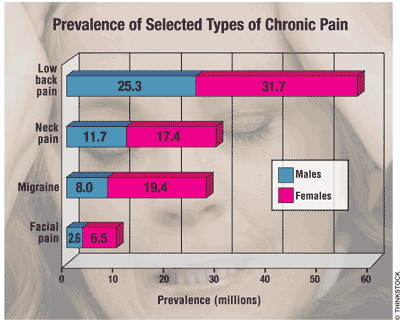US Pharm. 2010;35(5):6.
Chronic pain affects 56 million adults. One-quarter of sufferers are treated for their chronic pain, whereas 40% do not seek professional assistance. The top disease-specific contributors to chronic pain are osteoarthritis, rheumatoid arthritis, fibromyalgia, and sickle-cell anemia. Over the last decade, sales of pain-management medications have steadily increased at the rate of 5% per year, and future sales will continue to increase as more of these drugs are available generically.

One-quarter of nursing-home residents experience pain. Effective pain management enhances the quality of life of these patients, but, according to CDC analysis, 44% of nursing-home residents with pain had neither standing orders for pain medication nor appropriate pain management. Among residents with dementia and pain, nonwhites were more likely than whites to lack appropriate pain management, even though 17% and 24% of nonwhite and white residents, respectively, showed signs of pain. However, 56% of residents received appropriate pain-management therapies.
Low Back Pain
Low back pain, which is experienced by 16 million people, causes 93 million days of lost work, and Americans spend $50 billion each year to treat it. The CDC estimates that 60% to 80% of people will be affected by some form of low back pain during their lifetime. Five percent to 10% of people with back pain eventually develop chronic low back pain, and 1% become disabled. Back pain is the second leading reason for physician office visits, the third most common reason for surgery, and the fifth most common reason for hospital admission. It is also the most common cause of job-related disability, a frequent cause of disability in people younger than 45 years, and the second most common neurologic ailment reported by patients (after headache). Men and women are equally affected.
Low back pain occurs most often between ages 30 and 50 years, due in part to the aging process, but also as a result of a sedentary lifestyle with little exercise. The risk of experiencing low back pain from disc disease or spinal degeneration increases with age. Prevalence generally declines with greater levels of education and increasing income. Even though 13.7 million people visited a physician’s office primarily for low back pain in 2001, the proportion of all physician visits attributable to low back pain has changed little since the early 1990s.
Low back pain frequently is progressive, and the cause can be difficult to determine. Although most patients improve within the first 3 months, the CDC estimates that up to 75% of patients with low back pain experience one or more relapses at some point.
To comment on this article, contact rdavidson@uspharmacist.com.





